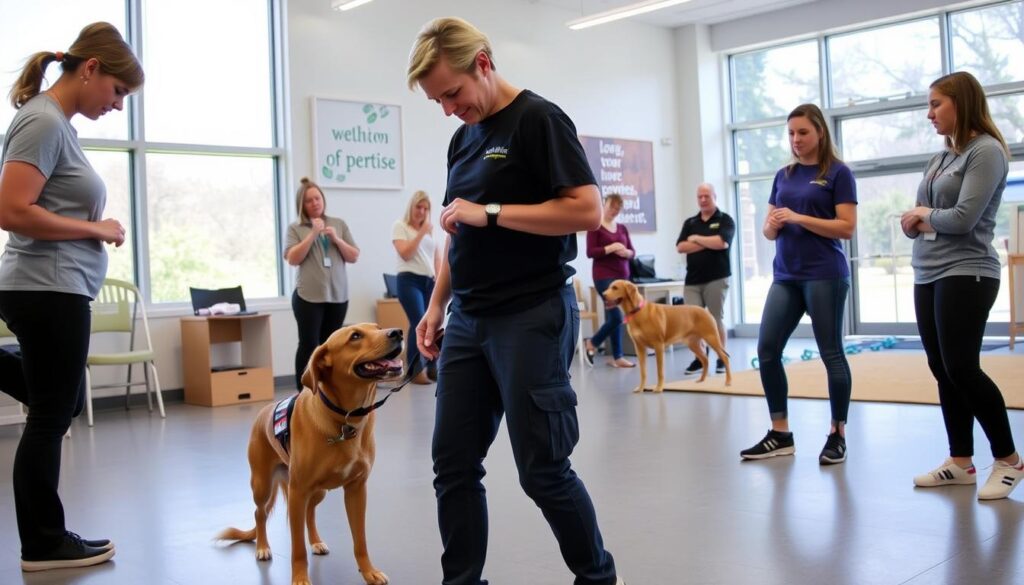Embarking on the path of working with service dogs is a deeply fulfilling experience! These incredible animals are trained to assist individuals with specific needs, offering independence and companionship. Unlike pets, service dogs undergo rigorous training to master obedience, public access, and specialized tasks. This ensures they can support their handlers in everyday life as a Service Dog Trainer.

As a trainer, you’ll play a vital role in shaping these dogs’ abilities and behaviors. It’s a career that blends patience, empathy, and consistency, helping the animal and the person they assist. Whether guiding a dog to learn new skills or supporting a handler, your impact is profound.
This article will walk you through the steps to begin this rewarding journey. From understanding the standards set by ADA guidelines to learning from top training programs, we’ve got you covered. Let’s dive in and explore how you can make a difference in the lives of dogs and people!
Key Takeaways
- Unlike regular pets, service dogs are trained to assist individuals with specific needs.
- Trainers play a crucial role in shaping a dog’s obedience and specialized skills.
- This career requires patience, empathy, and consistency for success.
- ADA guidelines and professional programs set high standards for training.
- Working with service dogs is a rewarding way to improve the quality of life for both dogs and handlers.
Understanding Service Dogs and Their Roles
Service dogs are more than just companions; they are lifelines for many individuals. These specially trained animals support people with disabilities, helping them navigate daily life more independently. Unlike pets, service dogs undergo rigorous training to master specific tasks and behaviors.
What is a Service Dog?
A service dog is a highly trained animal that assists individuals with disabilities. It performs tasks tailored to its handler’s needs, such as guiding the visually impaired or alerting someone with hearing loss. Because of its specialized training and public access rights, service dogs are distinct from emotional support animals or pets.
According to the ADA, a service dog is defined as a dog that is individually trained to do work or perform tasks for a person with a disability. This legal standard ensures that these animals are recognized for their vital role in improving the quality of life.
A Step-by-Step Training

Key Tasks and Responsibilities
Service dogs are trained to perform a variety of tasks. These include guiding individuals with visual impairments, retrieving items, and providing mobility assistance. They can also alert their handlers to sounds, such as doorbells or alarms, and offer a comforting presence during stressful situations.
Obedience training and socialization are critical for these dogs. They must remain calm and focused in public spaces, ensuring they can assist their handlers effectively. Patience and consistency from the trainer are key to shaping these behaviors.
“A service dog is not just a helper; they are a partner in life.”
The relationship between a service dog and its handler is built on trust and communication. Trainers play a crucial role in fostering this bond, ensuring the dog understands its responsibilities and the handler feels confident in its assistance.
Whether guiding someone across a busy street or alerting them to a medical issue, service dogs profoundly impact them. Their training and dedication are a testament to the incredible abilities of these animals and the trainers who shape them.
The Demand and Opportunity for Service Dog Trainers
With over half a million Americans relying on service dogs, the need for skilled trainers has never been greater. These professionals play a vital role in improving the lives of individuals with disabilities, offering both independence and companionship. The demand for trainers is rising, making this career both impactful and fulfilling.
Career Benefits and Job Outlook
The field of service dog training offers numerous benefits. Trainers enjoy a dynamic and rewarding career, from personal fulfillment to professional growth. According to industry data, the job outlook for trainers is promising, with opportunities ranging from individual businesses to larger instructional programs.
Here’s a quick comparison of career benefits:
| Benefit | Description |
|---|---|
| Personal Fulfillment | Helping individuals with disabilities achieve greater independence. |
| Professional Growth | Opportunities for mentorship and hands-on training. |
| Job Security | Growing demand for skilled trainers ensures stable employment. |
Impact on the Community
Service dog trainers make a profound difference in their communities. By preparing dogs to assist individuals with disabilities, they contribute to improved quality of life and safety. Programs like those at Bergin University showcase the positive impact of well-trained service dogs.
“Training a service dog is not just a job; it’s a way to change lives.”
Whether it’s guiding someone with visual impairments or alerting a person to a medical issue, the work of trainers is transformative. Their dedication ensures that both the dog and the handler can thrive together.
Essential Skills and Personal Traits for Trainers
Building a career as a service dog trainer requires a unique blend of skills and personal traits. Beyond technical expertise, success in this field hinges on qualities like empathy, patience, and adaptability. These traits help trainers connect with dogs and their handlers, ensuring effective training and lasting partnerships.

Communication and Empathy
Strong communication is vital for trainers. You’ll need to convey instructions to the dog while understanding the handler’s needs. Empathy plays a key role here, allowing you to connect with individuals facing challenges and tailor your approach to their unique situation.
For example, breaking down complex commands into smaller steps can make learning easier for the dog. Consistent praise and positive reinforcement build trust and encourage progress. This nurturing approach fosters a strong bond between the dog and their handler.
Patience, Adaptability, and Attention to Detail
Patience is essential when teaching new behaviors or addressing distractions. Dogs learn at their own pace, and trainers must remain calm and consistent throughout the process. Adaptability is equally important, as unexpected challenges often arise during training.
Attention to detail ensures the dog’s reliability in various environments. From busy streets to quiet homes, a well-trained service dog must perform tasks accurately and confidently. Here’s a quick comparison of these traits:
| Trait | Importance |
|---|---|
| Patience | Allows for steady progress and reduces frustration. |
| Adaptability | Helps overcome unexpected challenges during training. |
| Attention to Detail | Ensures the dog’s reliability in diverse environments. |
These skills are the foundation of a successful training career. By nurturing these traits, you’ll shape the dog’s abilities and positively impact the lives of its handlers. It’s a rewarding journey that combines technical expertise with heartfelt connections.
Training Basics: Laying the Foundation for a Service Dog
Mastering the basics of obedience and socialization is crucial for laying the foundation for a service dog. These early steps are crucial for shaping a dog’s ability to assist individuals with specific needs. Focusing on structured training and consistent practice ensures the dog is well-prepared for advanced tasks.

Obedience Training and Socialization
Obedience training is the cornerstone of preparing a service dog. It involves teaching commands like sit, stay, and heel, which are essential for public access and daily tasks. Socialization helps the dog adapt to various environments and remain calm in different situations.
Rewards and consistency are key to practical training. Positive reinforcement, such as treats or praise, encourages the dog to repeat desired behaviors. Structured sessions, scheduled regularly, help reinforce learning and build a strong bond between the dog and their handler.
Here’s a quick overview of the core principles:
| Principle | Description |
|---|---|
| Obedience | Teaching basic commands for control and reliability. |
| Socialization | Exposing the dog to diverse environments and people. |
| Consistency | Maintaining regular training sessions for steady progress. |
| Positive Reinforcement | Using rewards to encourage desired behaviors. |
Leading training programs emphasize the importance of routine and discipline. With commitment and patience, these foundational principles pave the way for advanced service dog training. The result is a well-rounded animal ready to assist their handler confidently and skillfully.
how to become a service dog trainer: Step-by-Step Guide
Starting a career in shaping service dogs is both rewarding and impactful. This journey combines passion, skill, and a deep commitment to helping individuals with disabilities. Let’s explore the steps to build a successful career in this field, from education to hands-on experience.
Education, Certification, and Formal Training
Formal education is the first step toward becoming a skilled trainer. Reputable institutions like Bergin University offer specialized programs that cover obedience, task training, and public access skills. These courses provide the knowledge needed to prepare dogs for their vital roles.
Certification adds credibility to your expertise. Organizations such as the International Association of Canine Professionals (IACP) offer certifications that validate your skills. This not only boosts your credentials but also opens doors to more opportunities.
Here’s a quick overview of what formal training includes:
- Obedience and behavior modification techniques.
- Task-specific training tailored to individual needs.
- Public access and socialization skills.
On-the-Job Experience and Mentorship
Hands-on experience is invaluable in this field. Working alongside experienced trainers allows you to refine your skills and learn real-world techniques. Mentorship provides guidance and insights that textbooks can’t offer.
Joining specialized programs or organizations can accelerate your growth. These platforms connect you with professionals who share your passion and can help you navigate challenges. Practical experience ensures you’re well-prepared to handle diverse training scenarios.
“Mentorship transforms theoretical knowledge into practical expertise.”
Combining education with real-world practice will build a strong foundation for your career. This structured approach ensures every step builds on the previous one, leading to long-term success.
Navigating Industry Standards and Legal Considerations
Navigating the world of service dog training involves understanding key legal and industry standards. These guidelines ensure that both trainers and handlers can work confidently within the law’s framework. Let’s explore the essential regulations and the role of professional organizations in maintaining high standards.
Understanding the ADA and Service Dog Regulations
The Americans with Disabilities Act (ADA) is the cornerstone of service dog regulations. It protects the rights of individuals with disabilities to have their assistance animals in public spaces. Notably, the ADA does not require certification for service dogs, focusing instead on the dog’s ability to perform specific tasks.
Service dogs must meet specific behavior standards. They should remain calm, focused, and non-disruptive in public settings. Trainers must ensure these behaviors are ingrained through consistent practice and positive reinforcement.
“The ADA ensures that service dogs are recognized for their vital role in improving quality of life.”
Role of Registries and Professional Organizations
While the ADA does not mandate registration, independent registries like the United States Service Dog Registry (USSDR) set higher training and behavior standards. These registries provide additional credibility and help reduce the misuse of service dog titles.
Professional organizations, such as the Association of Professional Dog Trainers (APDT) and the Certification Council for Professional Dog Trainers (CCPDT), offer resources and certifications. These bodies ensure trainers stay updated on best practices and regulatory changes.
Here’s how these organizations contribute:
- Provide certification programs to validate expertise.
- Offer continuous education to keep trainers informed.
- Set ethical standards for the industry.
By adhering to these standards, trainers build trust with clients and the public. This commitment ensures that service dogs can perform their tasks effectively, making a real difference in the lives of their handlers.
Conclusion
Shaping the future of assistance animals is a journey filled with purpose and connection. From mastering obedience to understanding legal standards, every step prepares you to make a lasting impact. Empathy and consistency are the cornerstones of this work, ensuring the animal and their handler thrive together.
This career is more than a job; it’s a way to transform lives. Dedicating yourself to training provides independence and companionship to those in need. The bond between a handler and their assistance dog is a testament to your hard work and passion.
We invite you to join our community of dedicated professionals. Explore certification programs and mentorship opportunities to continue growing in this rewarding field. Together, we can uphold the highest standards and ensure every assistance dog is ready to serve.
Thank you for taking this step toward a meaningful career. Your commitment to training will bring hope and independence to countless individuals. Let’s make a difference, one dog at a time!
FAQ
What is a service dog?
A service dog is a specially trained animal that assists individuals with disabilities. It performs specific tasks to help its handlers navigate daily life with greater independence.
What are the key tasks a service dog performs?
Service dogs can guide the visually impaired, alert those with hearing loss, provide mobility support, or even detect medical emergencies like seizures or low blood sugar.
Why is there a growing demand for a service dog Trainer?
As awareness of disabilities increases, so does the need for well-trained assistance animals. Trainers play a vital role in matching dogs with handlers to improve their quality of life.
What skills are essential for a successful Service Dog Trainer?
Strong communication, empathy, patience, and attention to detail are crucial. Trainers must adapt to each dog’s unique personality and the handler’s specific needs.
What’s the first step in training a Service Dog Trainer?
Start with basic obedience and socialization. A well-behaved, confident dog is the foundation for learning specialized tasks later on.
Do I need certification to become a service dog trainer?
While not always required, certification through recognized programs can enhance your credibility and open doors to more opportunities in the field.
What legal standards apply to a Service Dog Trainer?
The Americans with Disabilities Act (ADA) defines the rights and responsibilities of handlers and trainers. Understanding these regulations ensures compliance and ethical practices.
How can I gain hands-on experience in this field?
Seek mentorship from experienced trainers or volunteer with organizations that train assistance animals. Real-world experience is invaluable for honing your skills.







